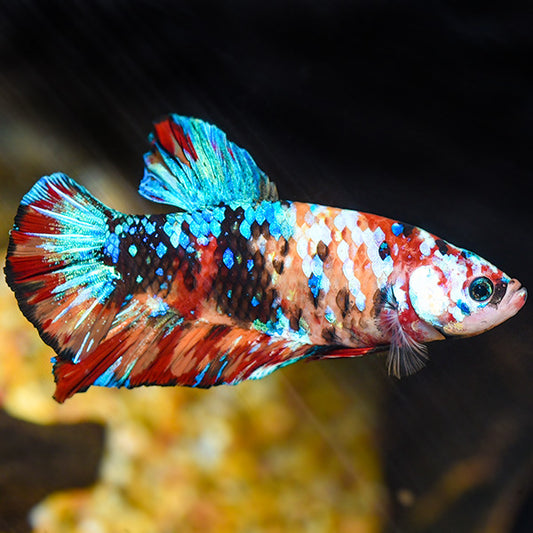Betta Fish Care: Crucial Tips for a Healthy and Happy Animal
Betta Fish Care: Crucial Tips for a Healthy and Happy Animal
Blog Article
Just How to Reproduce Betta Fish Successfully: Expert Methods and Insights for Hobbyists Wanting To Expand Their Betta Collection
Breeding Betta fish requires a nuanced understanding of genetics and environmental problems, making it essential for hobbyists to come close to the procedure with both persistance and care. Creating an ideal reproduction setting, selecting the best pairs, and observing the ins and outs of their courtship actions are fundamental actions that can considerably affect the result.
Recognizing Betta Fish Genes
Understanding the genetics of Betta fish is essential for effective reproduction, as it affects attributes such as shade, fin form, and behavior. Betta fish exhibit a diverse range of colors and patterns, mainly figured out by their hereditary make-up. The key genetics liable for pigmentation include the "B" genetics for blue, "D" genetics for red, and the "C" gene for shade intensity. Dog breeders can control these traits by choosing certain moms and dad fish that exhibit desired qualities.
Along with pigmentation, fin morphology is an additional substantial facet of Betta genes (betta fish). The sizes and shape of fins are influenced by numerous genes, including those that determine whether the fins are short, long, or veil-shaped. Understanding these hereditary variations helps breeders predict the phenotypic results of their offspring
Moreover, behavior qualities such as aggression and territoriality can also be influenced by genetics. These actions play a crucial function in the reproducing process, as they can impact generating success and the overall character of the resulting fry. By comprehensively recognizing these hereditary concepts, breeders can make educated choices, inevitably boosting their breeding programs and accomplishing desirable results.
Preparing the Breeding Environment
Developing an ideal reproduction setting is important for the effective reproduction of Betta fish. The very first step in preparing this setting is to pick an appropriate breeding tank, preferably ranging from 5 to 10 gallons. This size permits adequate swimming room and the establishment of territories. The storage tank needs to be outfitted with a heating system to keep a secure temperature level between 78 ° F and 80 ° F, which is vital for urging spawning habits.
Next, think about using a sponge filter or an air rock to supply mild water circulation without creating solid currents that can stress the fish. It is necessary to install plants or breeding cones to supply hiding areas and advertise comfort for the woman during the spawning procedure. Floating plants, such as Java moss or water sprite, can additionally produce a much more natural setting while assisting in bubble nest building by the male.
Before introducing the breeding pairs, make certain the water is conditioned and without damaging chemicals, such as chlorine or hefty metals. betta fish. Normal water adjustments should be conducted to maintain optimal water quality, boosting the chances of effective reproduction. With these prep work in area, the reproducing atmosphere will support the health and well-being of both Betta fish
Picking Reproduction Pairs
Picking the ideal breeding sets is important for achieving effective Betta fish reproduction. Healthy and balanced Betta fish display vibrant shades, clear eyes, and active actions.
Character is another crucial consideration, as Betta fish are recognized for their aggressive nature. It is suggested to select a man and female that show compatible personalities to reduce stress during the reproducing process. A tranquil male browse around this site can urge a smoother courtship, while a woman that is also hostile may interfere with the process.
Hereditary background additionally plays a significant function in the top quality of the children. Reproducing fish that are genetically diverse can minimize the risk of hereditary wellness issues and improve the overall vigor of the fry. It is advantageous to look into the lineage of both the man and female, focusing on preferable traits such as fin type, color scheme, and dimension.
The Breeding Refine
The reproduction process of Betta fish calls for cautious preparation and attention to detail to make certain a successful result. It is essential to prepare a suitable breeding storage tank, preferably a 5-10 gallon fish tank with a temperature level maintained at 78-80 ° F. The tank ought to be directory geared up with a heating unit, filter (ideally sponge kind to stay clear of solid currents), and plenty of water plants for the woman to hide.
When the atmosphere is established, present the picked reproducing set to the tank, allowing them to accustom. Observe their habits; the man will show sophisticated courtship routines, consisting of flaring his fins and constructing a bubble nest. If the female shows interest, she will present upright red stripes showing preparedness for spawning.
When the lady is receptive, the set will certainly engage in a mating accept, throughout which the male fertilizes the eggs. Maintaining ideal water problems during this duration is necessary for the advancement of healthy Betta fry.
Taking Care Of Betta Fry

Feeding Betta fry is vital, as they call for a diet high in protein. At first, they can be fed infusoria or fluid fry food, transitioning to carefully crushed top quality pellets as they expand. Feed little parts numerous times a day to urge healthy and balanced growth without overloading the tank with uneaten food.

As they mature, check their growth very closely and separate any kind of aggressive people to stop harm. By supplying a nurturing setting and proper nourishment, hobbyists can effectively raise Betta fry into vibrant, healthy fish, inevitably enhancing their reproduction endeavors.
Final Thought
Effective Betta fish breeding requires precise interest to hereditary choice, ecological problems, and treatment for the fry. By recognizing the genes of Betta fish and preparing an ideal breeding environment, hobbyists can enhance the chances of producing dynamic, healthy offspring.
Report this page